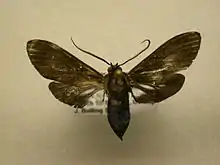Episcepsis sixola
Episcepsis sixola is a moth of the family Erebidae. It was described by William Schaus in 1910. It is found in Costa Rica.[1]
| Episcepsis sixola | |
|---|---|
 | |
| Scientific classification | |
| Kingdom: | Animalia |
| Phylum: | Arthropoda |
| Class: | Insecta |
| Order: | Lepidoptera |
| Superfamily: | Noctuoidea |
| Family: | Erebidae |
| Subfamily: | Arctiinae |
| Genus: | Episcepsis |
| Species: | E. sixola |
| Binomial name | |
| Episcepsis sixola Schaus, 1910 | |
| Synonyms | |
| |
Description
Palpi and legs brown black. Palpi with a white spot on first segment. White spots at base and end of coxae; fore coxae streaked with white in male, with roseate in female. Collar and thorax brown black, the former with dorsal and lateral red spots. Abdomen dull blue black, underneath with two rows of white spots. Primaries brown black, the veins still darker; a vague subterminal broad darker shade. Secondaries black; a short white streak in cell, and a large white patch at base of inner margin; some white scales beyond cell between veins 2 and 5. The female's wing span is 37 mm and the male's 34 mm.[2]
References
- Savela, Markku. "Episcepsis sixola Schaus, 1910". Lepidoptera and Some Other Life Forms. Retrieved August 27, 2019.
- The Annals and Magazine of Natural History
External links
- E. sixola at EOL
- "Taxonomy Browser: Episcepsis sixola". Barcode of Life Data System. Retrieved August 27, 2019.
- Beccaloni, G.; Scoble, M.; Kitching, I.; Simonsen, T.; Robinson, G.; Pitkin, B.; Hine, A.; Lyal, C., eds. (2003). "Epidesma sixola". The Global Lepidoptera Names Index. Natural History Museum. Retrieved May 3, 2018.
This article is issued from Wikipedia. The text is licensed under Creative Commons - Attribution - Sharealike. Additional terms may apply for the media files.